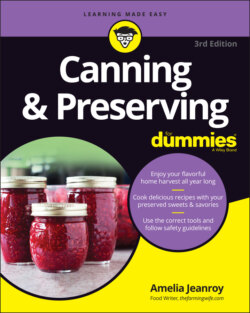Читать книгу Canning & Preserving For Dummies - Amelia Jeanroy - Страница 60
Determining what you need to dispose of
ОглавлениеNo one can promise you that your home-canned foods will always be free from spoilage, but you can rest assured that your chances for spoiled food are greatly reduced when you follow the precise guidelines for each preserving method. However, if you suspect, for any reason, that your food is spoiled or just isn’t right, don’t taste it. Instead, take a time-out to better evaluate the contents. For starters, the best way to detect food spoilage is by visually examining your jars. Review the following checklist. If you can answer “true” for each of the following statements, then your food should be safe for eating:
The food in the jar is covered with liquid, is fully packed, and has maintained the proper headspace.
The food in the jar is free from moving air bubbles.
The jars have good, tight seals.
The food has maintained a uniform color.
The food isn’t broken or mushy.
The liquid in the jar is clear, not cloudy, and free of sediment.
After your food has passed this preliminary checklist, examine your jars more closely. Truth is, just because your food doesn’t look spoiled doesn’t mean that it’s not. If you discover any spoilage during any step of this process, don’t continue your search, but properly dispose of your product.
1 Hold the jar at eye level.
2 Turn and rotate the jar, looking for any seepage or oozing from under the lid that indicates a broken seal.
3 Examine the food surface for any streaks of dried food originating at the top of the jar.
4 Check the contents for any rising air bubbles or unnatural color.The food and liquid should be clear, not cloudy.
5 Open the jar.There shouldn’t be any spurting liquid.
6 Smell the contents of the jar.Take note of any unnatural or unusual odors.
7 Look for any cottonlike growth, usually white, blue, black, or green, on the top of your food surface or on the underside of the lid.
Spoiled low-acid food may exhibit little or no visual evidence of spoilage. Treat any jars that are suspect as if they contain botulism toxins. Follow the detailed instructions for responsibly disposing of spoiled, low-acid food in Chapter 9. Never use or taste any canned food that exhibits signs of spoilage or that you suspect is spoiled. Boiling will not make spoiled food safe to eat.
Removing the screw bands from your cooled, sealed jars before storing them allows you to easily detect any broken seals or food oozing out from under the lid, which indicates spoilage. Screw bands can also create a “false seal.” Screw bands that are left on jars can easily corrode and adhere to the jars, making them impossible to open safely.
